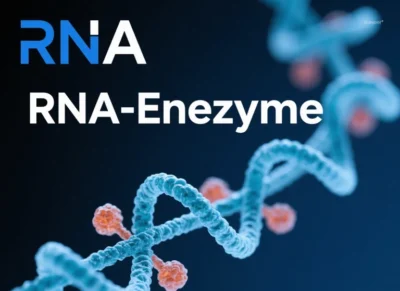
RNA Enzyme (Ribozyme): Definition and In-Depth Analysis
RNA Enzyme (ribozyme) refers to a class of RNA molecules capable of catalyzing specific biochemical reactions independently of proteins. This discovery颠覆ed the traditional enzymology dogma that “all enzymes must be proteins,” revealing the multifunctional role of RNA in biological processes. Below is a comprehensive exploration from multiple perspectives.
I. Definition and Core Concepts
- Basic Definition
Ribozymes are catalytic RNA molecules whose activity arises from their three-dimensional structures. Like protein enzymes, ribozymes lower the activation energy of reactions, accelerate substrate conversion, and remain unchanged throughout the process. - Types of Catalyzed Reactions
- Phosphodiester Bond Cleavage/Ligation: Self-cleaving ribozymes (e.g., HDV ribozyme) catalyze RNA strand breakage or rejoining.
- Peptide Bond Formation: Ribosomal rRNA (e.g., 23S rRNA in bacteria) catalyzes peptide bond synthesis during protein translation.
- Non-Canonical Reactions: Engineered ribozymes can perform ester hydrolysis, glycosyl transfer, and other artificial reactions.
II. Historical Milestones
- 1982: Thomas Cech’s team discovered self-splicing rRNA precursors in Tetrahymena, proving RNA’s catalytic ability.
- 1983: Sidney Altman identified the catalytic RNA component (M1 RNA) of RNase P, essential for tRNA maturation.
- 1989: Cech and Altman shared the Nobel Prize in Chemistry for their ribozyme discoveries.
- 2000: High-resolution ribosome structures confirmed rRNA’s role as the catalytic core, supporting the RNA World Hypothesis.
III. Classification and Mechanisms
Ribozymes are categorized by structure and catalytic mechanisms:
| Category | Representative Ribozymes | Catalytic Mechanism | Biological Role |
|---|---|---|---|
| Self-Cleaving Ribozymes | HDV ribozyme, Hammerhead ribozyme | Base-pairing forms active sites; Mg²⁺-dependent phosphodiester bond cleavage/ligation | Viral replication, RNA processing |
| Spliceosomal Ribozymes | Tetrahymena group I intron | Two-step transesterification for self-splicing | Eukaryotic mRNA maturation |
| Ribosomal rRNA | 23S rRNA (bacteria) | General acid-base catalysis (e.g., 2′-OH deprotonation) for peptide bond formation | Protein biosynthesis |
| RNase P | M1 RNA (bacteria) | Cleaves tRNA precursor 5′ leaders | tRNA maturation |
| Artificial Ribozymes | SELEX-evolved ribozymes | Catalyze non-natural reactions (e.g., Diels-Alder cyclization, RNA polymerization) | Synthetic biology tools |
IV. Biological Significance
- Evidence for the RNA World Hypothesis
Ribozymes support the theory that early life relied on RNA for both genetic storage and catalysis, simplifying primordial biochemical systems. - Gene Expression Regulation
- Non-coding RNA roles: Long non-coding RNAs (lncRNAs) with ribozyme activity modulate chromatin remodeling or mRNA stability.
- Viral replication: Hepatitis Delta Virus (HDV) uses self-cleaving ribozymes for efficient RNA genome processing.
- Evolutionary Conservation
Ribozymes are conserved across bacteria, archaea, and eukaryotes (e.g., ribosomal rRNA), indicating ancient evolutionary origins.
V. Applications
- Therapeutics and Drug Development
- Targeted mRNA silencing: Engineered ribozymes cleave disease-related mRNAs (e.g., HIV, oncogenes) with minimal off-target effects.
- Vaccine optimization: Ribozymes enhance mRNA vaccine stability or translational efficiency.
- Synthetic Biology Tools
- Ribozyme switches: Chemically regulated gene expression systems for biosensors or metabolic engineering.
- Self-replicating systems: Artificial ribozyme networks mimicking early life.
- Environmental and Industrial Uses
- Heavy metal detection: Lead-dependent ribozyme variants serve as biosensors for environmental monitoring.
- Biocatalysis: Ribozymes synthesize chiral pharmaceuticals, replacing traditional chemical catalysts.
VI. Ribozymes vs. Protein Enzymes
| Feature | Ribozymes | Protein Enzymes |
|---|---|---|
| Chemical Composition | RNA (ribose, uracil) | Proteins (amino acids) |
| Catalytic Diversity | Primarily RNA-related reactions; limited non-RNA catalysis | Broad range (oxidation, hydrolysis, isomerization) |
| Structural Stability | Relies on secondary structures (stem-loops, pseudoknots); sensitive to ions | Tertiary/quaternary structures; higher stability |
| Evolutionary Origin | Likely central to early life | Evolved later via genetic optimization |
| Catalytic Rate | Slower (e.g., ribosomal peptide bond formation: 2–20 bonds/sec) | Extremely fast (e.g., catalase: millions of reactions/sec) |
| Cofactor Requirement | Often requires Mg²⁺ or other divalent ions | Diverse coenzymes (e.g., NAD⁺) and cofactors (e.g., heme) |
VII. Challenges and Future Directions
- Enhancing Catalytic Efficiency: Optimize ribozymes via directed evolution or rational design.
- Delivery Systems: Improve in vivo stability and targeting (e.g., lipid nanoparticle encapsulation).
- Interdisciplinary Integration: Combine ribozymes with CRISPR, nanotechnology, or AI for novel diagnostics/therapeutics.
- Origins of Life Research: Construct self-replicating ribozyme networks to model primitive cells.
VIII. Classic Examples
- Hammerhead Ribozyme: Isolated from plant viruses; widely used in RNA mechanism studies and gene silencing.
- CPEB3 Ribozyme: The only known small self-cleaving ribozyme in mammals, linked to memory formation.
- Ribosome: The sole natural ribozyme catalyzing peptide bonds, constituting >80% of cellular RNA.
Conclusion
Ribozymes are dual-function macromolecules that revolutionized enzymology and provided insights into the origins of life, gene therapy, and synthetic biology. With advancing technology, ribozymes hold transformative potential in precision medicine, environmental monitoring, and industrial catalysis, bridging fundamental science and real-world applications.




